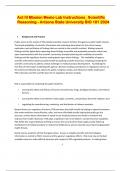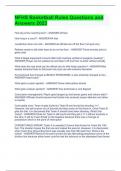Act III Mission Memo Lab Instructions_ Scientific
Reasoning - Arizona State University BIO 181 2024
I. Background and Purpose
Public access to the results of FDA-funded scientific research furthers the agency’s public health mission.
The broad availability of scientific information and underlying data allows for the critical review,
replication, and verification of findings that are central to the scientific method. Making research
findings and the digital data supporting those findings accessible and analyzable promotes robust and
open communication with the scientific community thereby bolstering the credibility of scientific
findings and the regulatory decision-making based upon those findings. The availability of agency
scientific information advances public health by sparking scientific discovery, including prompting the
scientific community to address critical challenges in medical product development. Facilitating the
free flow of information underlying the agency’s decision-making and advances in regulatory science, to
the extent permitted by law, allows the public, Congress, media, and industry to better understand
FDA’s decisions and the scientific basis for its regulatory decision-making.
FDA is responsible for protecting the public health by
• assuring the safety and efficacy of human and veterinary drugs, biological products, and medical
devices;
• assuring the safety of our Nation’s food supply, cosmetics, and products that emit radiation; and
• regulating the manufacturing, marketing, and distribution of tobacco products.
Beyond these core regulatory functions, FDA promotes the public health by helping to speed innovations
that make medicines more effective, safer, and more affordable and by helping the public get the
accurate, science-based information it needs to use medical products and foods to maintain and
improve their health. Moreover, FDA plays a significant role in the Nation’s counterterrorism capability.
FDA fulfills this responsibility by working to ensure the security of the food supply and by fostering
development of medical products to respond to deliberate as well as naturally occurring emerging public
health threats.
Sound science underlies all that the agency does. Access to reliable scientific and technological
information is central to FDA’s mission and the agency’s regulatory efforts. FDA must rely on the best
available science to make difficult decisions with respect to FDA-regulated products. In making those
1
,decisions, an unbiased presentation and full analysis of the relevant scientific data, including its
uncertainties, is absolutely critical. Establishing and maintaining the integrity of the scientific process
and of scientific data is crucial to the agency’s ability to arrive at sound decisions and to maintain public
trust.
In June 2009 FDA expressed its commitment to transparency as a tool for the protection of public health
by launching an agency-wide Transparency Initiative. 1 While the agency has embraced the values of
openness and transparency, the agency’s role as a regulator does present restrictions on the full and
free disclosure of scientific data. For example, FDA is limited in whether, how, and when it may disclose
certain information submitted to the agency as part of investigational new drug or other marketing
applications. Even in its capacity as a research institution, the agency can face restrictions on the
disclosure of information and data. For example, the agency may conduct research based on data
submitted by third parties related to medical products or conduct research to develop data to support
ongoing regulatory decision-making or administrative or criminal investigations that would be precluded
from disclosure. In general, the agency is restricted from disclosing information by statute, regulation,
and policy, including, but not limited to
• information that constitutes trade secret and confidential commercial information, or that
otherwise must be protected to preserve intellectual property rights;
• privileged information, including information related to ongoing product reviews, regulatory
decision-making, and ongoing criminal or administrative investigations;
• personal privacy information; and
• national security and other classified information.
On February 22, 2013, the White House Office of Science Technology and Policy (OSTP) issued a
memorandum to the heads of executive departments and agencies entitled “Increasing Access to the
Results of Federally Funded Scientific Research” (OSTP Memo or Public Access Memo). In the
memorandum, OSTP asks federal agencies with research and development budgets greater than $100
million per year to develop a plan to ensure free public access to federally-funded, peer-reviewed
scientific publications and to maximize public access—to the extent feasible and permitted by law—to
digital data resulting from federally funded research. FDA shares the objectives of transparency and
maximizing public access to FDA funded research. Accordingly, it has developed this plan for public
access to FDA-funded peer-reviewed publications and digitally stored data.
On May 9, 2013, the President issued an executive order, “Making Open and Machine Readable the New
Default for Government Information” (Open Data Executive Order). The same day, the Office of
1
See http://www.fda.gov/AboutFDA/Transparency/TransparencyInitiative/default.htm
2
, Management and Budget issued an accompanying memorandum, “Open Data Policy—Managing
Information as an Asset” (Memorandum M-13-13) that issues directives and guidance to executive
agencies regarding the steps to be taken in making government data open and machine-readable.
While the Open Data Executive Order and associated Memorandum M-13-13 constitute a distinct
initiative from the OSTP effort to increase public access to federally funded research, it similarly asks
executive agencies to expand access to government information.
The HHS Memorandum accompanying this plan describes the Department-wide efforts to comply with
the Open Data Executive Order and Memorandum M-13-13. Moreover, FDA’s Office of Informatics and
Technology Innovation has recently launched its openFDA open data initiative (http://open.fda.gov).
OpenFDA will make FDA’s publicly-available datasets accessible in a structured, machine-readable
format. As one of its first accomplishments, the initiative has provided a search-based Application
Programming Interface (API) to make it possible to find both structured and unstructured content
online. The API also provides a tool to allow software developers to build their own applications (such
as mobile phone apps or interactive websites) that can quickly search, query, or pull public information
instantaneously and directly from publicly-available datasets on openFDA. Four datasets have been
made available in openFDA related to adverse events, recalls, and product labeling. Several websites
already make routine use of data on openFDA. OpenFDA is in its early stages, but the agency will be
listening closely to the public, researchers, industry, and all other users for their feedback on how to
make openFDA even more useful in promoting and protecting the public health.
While FDA recognizes that the agency and Departmental open-data efforts overlap with, and may
expand upon, FDA’s plan to increase access to FDA-funded research, this document maintains its focus
on implementing the specific requirements of the Public Access Memo. In particular, the document
centers on making FDA-funded or –conducted, peer-reviewed, scientific articles freely available to the
public and ensuring that FDA intramural and extramural researchers conduct research under approved
data management plans.
II. Definitions
Peer-Reviewed Article
For the purposes of this plan, the phrase “peer-reviewed article” is defined as an article describing
original scientific research findings published in a scholarly scientific journal that has been peerreviewed
prior to publication.
Final peer-reviewed manuscript
3






